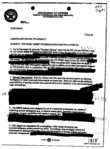Memory hole
A memory hole is any mechanism for the alteration or disappearance of inconvenient or embarrassing documents, photographs, transcripts, or other records, such as from a website or other archive, particularly as part of an attempt to give the impression that something never happened.[1][2] The concept was first popularized by George Orwell's dystopian novel Nineteen Eighty-Four, where the Party's Ministry of Truth systematically re-created all potential historical documents, in effect, re-writing all of history to match the often-changing state propaganda. These changes were complete.
Origins
In Nineteen Eighty-Four the memory hole is a small chute leading to a large incinerator used for censorship:[3][4]
In the walls of the cubicle there were three orifices. To the right of the speakwrite, a small pneumatic tube for written messages, to the left, a larger one for newspapers; and in the side wall, within easy reach of Winston's arm, a large oblong slit protected by a wire grating. This last was for the disposal of waste paper. Similar slits existed in thousands or tens of thousands throughout the building, not only in every room but at short intervals in every corridor. For some reason they were nicknamed memory holes. When one knew that any document was due for destruction, or even when one saw a scrap of waste paper lying about, it was an automatic action to lift the flap of the nearest memory hole and drop it in, whereupon it would be whirled away on a current of warm air to the enormous furnaces which were hidden somewhere in the recesses of the building.[5]
In the novel, the memory hole is a slot into which government officials deposit politically inconvenient documents and records to be destroyed. Nineteen Eighty-Four's protagonist Winston Smith, who works in the Ministry of Truth, is routinely assigned the task of revising old newspaper articles in order to serve the propaganda interests of the government. For example, Smith may be called to retroactively change a statement about food rationing to reflect new policies.
The memory hole is referenced while O'Brien tortures Smith; O'Brien produces evidence of a coverup by the Party, exciting Smith that such documentation exists. However, O'Brien then destroys the evidence in the memory hole and denies not only the existence of the evidence but also any memory of his actions. Smith realizes that this is doublethink in action, as O'Brien has actively suppressed his memory of both a politically inconvenient fact and his action taken to destroy the evidence of it.[6]
See also
- /dev/null
- Ash heap of history
- Blue Code of Silence
- Damnatio memoriae
- Doublethink
- Groupthink
- Propaganda
- Retcon
- Revisionism
- Right to be forgotten
- Social control
- Spiral of silence
- The Memory Hole, a website whose goal was to preserve documents which were in danger of being lost.
References
Inline
- ↑ Murphy, Kirk, Memorial Day Memory Hole: After Israel Forgets “Exodus”, White House Forgets “Shores of Tripoli”. Will Obama Remember NATO? 31 May 2010 Firedoglake.com
- ↑ Weinstein, Adam, Nevada Tea Partier's Memory Hole, 9 June 2010. Mother Jones.
- ↑ Pittis, Don (13 May 2014). "Google's memory hole a bottomless pit: Don Pittis". cbc.ca. Retrieved 3 August 2014.
- ↑ Stone, Brad (19 July 2009). "Amazon Erases Orwell Books From Kindle". The New York Times. Retrieved 3 August 2014.
- ↑ Orwell (1954) pp. 34–35.
- ↑ Bhabha, Homi K. (2010). "Doublespeak and Minority of One". On "Nineteen Eighty-Four": Orwell and Our Future. Princeton University Press. pp. 32–33. ISBN 9781400826643.
General
- George Orwell, Nineteen Eighty-Four, first published by Martin Secker & Warburg, London, 1949. This reference, Penguin Books pocket edition, 1954.
External links
-
 The dictionary definition of memory hole at Wiktionary
The dictionary definition of memory hole at Wiktionary
